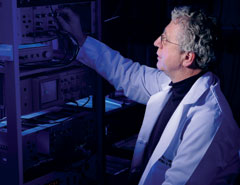New Facility Aligns Interdisciplinary Researchers in Fight Against Blindness
By Grant Martin
 |
Paul Gamlin, chair of the Department of Vision Sciences, is one of several researchers who will share space in the new EyeSight Foundation of Alabama Vision Science Research Laboratories |
When officials from the UAB schools of optometry (UABSO) and medicine dedicated a newly renovated research space in Volker Hall this past fall, it signaled more than just an expansion of laboratories. The state-of-the-art facility marked the start of a historic collaborative arrangement designed to break through the current limitations of vision science research and bring the scientific world closer to a full understanding of the diseases that cause blindness.
The EyeSight Foundation of Alabama Vision Science Research Laboratories will provide space for 15 researchers—including six from the UABSO’s Vision Science Research Center—who formerly occupied separate laboratories in the Callahan Eye Foundation Hospital, Worrell, Shelby, and Spain-Wallace buildings. “Our Vision Science Research Center has long been known for its innovative approaches through interdisciplinary research efforts,” says UABSO interim dean Rodney Nowakowski, O.D., Ph.D. (’75). “This new facility will accelerate many of our ongoing projects by bringing the participating researchers together in the same space. Our hope is that this arrangement will also help generate new ideas and new lines of inquiry for future research endeavors.”
Beating Blindness
Vision loss stems from a wide variety of diseases, including glaucoma, diabetic retinopathy, and age-related macular degeneration. Scientists in the new vision science research laboratories will focus on examining the underlying pathologies of these conditions and on uncovering the reasons why blinding diseases are so common in the southeastern United States. “The incidence of partial vision loss and blindness is disproportionately high in the Southeast,” says Paul Gamlin, Ph.D., chair of the Department of Vision Sciences, “so UAB is particularly well-suited for this type of facility. We hope to provide the infrastructure for research that will help prevent vision loss throughout the state, region, and nation.”
The facility was created through a $1.2-million grant from The EyeSight Foundation of Alabama, plus additional funds from the provost’s office and the schools of medicine and optometry. The open-lab design concept will enable several faculty members to share large, conjoined lab spaces, creating more opportunities for collaboration.
School of Optometry faculty relocating to the new labs include Paul Gamlin, Ph.D.; Alecia Gross, Ph.D.; Kent Keyser, Ph.D.; Timothy Kraft, Ph.D.; Thomas Norton, Ph.D.; Steve Pittler, Ph.D.; and Om Srivastava, Ph.D. Xincheng Yao, Ph.D., from the School of Engineering, will join them. Faculty from the School of Medicine moving into the new labs include Christine Curcio, Ph.D.; Christopher Girkin, M.D.; Clyde Guidry, Ph.D.; Judith Kapp, Ph.D.; Russell Read, M.D., Ph.D.; Shu-Zhen Wang, Ph.D.; and Yuhua Zhang, Ph.D.
Answering the Call
There are many practical advantages to bringing researchers together into a shared space. Less obvious, however, are the potential advantages that could come from the favorable impression such a facility might have on organizations funding research. After all, collaborative, interdisciplinary efforts between scientists have been commonplace at UAB for years, but having a facility dedicated to those collaborative relationships will increase visibility of the projects, thereby making UAB even more competitive for funding. “While much of the initial focus is on increasing the limits of basic research, there is an increased emphasis from the National Institutes of Health on translational research and even clinical treatments,” Gamlin says. “And the new labs put UAB in position to take advantage of that.”
“When you’re focused on your own area of research, which goes all the way down to the molecular level, it’s easy to wonder, ‘Is what I’m doing ever going to translate into a treatment for disease in my lifetime?’” adds Judith Kapp, Ph.D., the Department of Ophthalmology’s vice chair for basic research. “This facility creates an excellent environment where researchers can work together and imagine how their work is going to translate, and it will keep them focused.”
“The proximity of researchers will foster collaboration,” agrees Steven Pittler, Ph.D., who is currently working on retinal degeneration. “I am trying to understand the basic mechanisms of how the retina functions as well as conducting translational research in finding disease of the retina and related disorders. To have access to other researchers with different areas of expertise, as well as the opportunity to share some specialized equipment will be a huge advantage.”
The research labs were dedicated during a two-day celebration in September, which included a reception, dedication, and lab tour. Additionally, Paul Sieving, M.D., Ph.D., director of the National Eye Institute, was the featured speaker of the Vision Science Symposium, which coincided with the event.